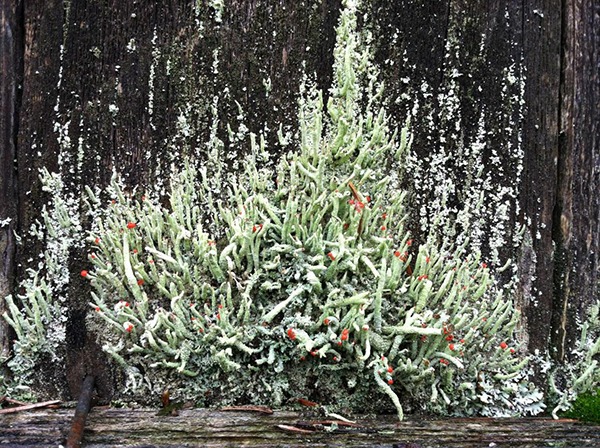In our coastal climate, we have lots of lichen in our surroundings.
Pronounced “LIKE-en,” there are over 1,000 varieties found in Washington. If you find lichens on your property, you can “breathe easier” knowing more about them.
Lichens have a biological classification within the fungi kingdom and take up about one-quarter of the world’s known fungi. Lichens are made up of fungi that have a symbiotic partnership, mostly with algae. Through photosynthesis, the alga creates carbohydrates to feed the fungi in exchange for a suitable supply of moisture and light.
Lichens serve very important functions in ecosystems by processing atmospheric nitrogen, making it available in the soil. They attach themselves to solid surfaces, drawing nutrients from the air. As the lichen grows, so does the soil below them through decomposition, which will eventually harbor seeds and moisture to feed the seeds, starting a lifecycle that could create a forest.
Because of the atmospheric role that they play, lichens are intolerant of air pollution, preferring rural areas over cities with poor air quality. Their sensitivity to airborne toxins makes them good subjects for scientists to measure and study pollution levels.
Taking on many types of forms in many colors on a variety of surfaces, lichens can be clubs or upright stems that grow on top of horizontal surfaces, crusts and scales appearing as patchwork on rocks, hairy fibers that hang from branches, dust or powdery granules, shrub-like with branching stems or leaf-like lobes that cling to trees. Some lichens are very pretty and some even bloom (see picture).
Lichens provide many benefits and resources to beneficial insects, wildlife and birds. If not eating lichen or from within it, they are using it for nesting and resting or building their homes.
Humans have used lichens for a variety of things. While some groups have consumed lichens as a way to survive drought and famine, others have considered lichens as a staple for making breads or even a delicacy. Some varieties in the past and still today are used as dyes for clothing. Lichens also have been used as remedies and cures for a host of wounds, conditions and diseases.
For the home gardener in Western Washington, lichen is a common sight on fruit and nut trees (see picture). It is often mistaken as a symptom or cause of disease on damaged and declining trees. However, lichens are nonparasitic and will not directly harm trees.
There is little need to control lichen unless it is interfering with spur production or has become heavy enough to cause breaking limbs. In those rare cases of heavy buildup, simply hand-pick the buildup with care to leave the bark undamaged. Pruning trees to open up the canopy and allowing for more sunlight and air-flow should be done for the health of the tree, as vigorous trees are not at any risk from lichen growth. Consider planting seedling trees in sunny areas to avoid lichen formation in the future.
So, relax and breathe easy knowing that without lichens, much of the world would be lifeless. If you stand in one place too long, they might even grow on you!
Michele Mangiantini is a Washington State University-certified, Clallam County Master Gardener.



